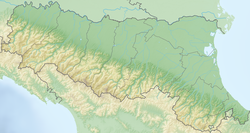Ferrara Synagogue
| Ferrara Synagogue | |
|---|---|
Italian: Sinagoga di Ferrara | |
 The synagogue façade, in 2017 | |
| Religion | |
| Affiliation | Judaism |
| Rite |
|
| Ecclesiastical or organisational status | |
| Status | Active |
| Location | |
| Location | Via Mazzini 95, Ferrara, Emilia-Romagna |
| Country | Italy |
Location of the synagogue complex in Emilia-Romagna | |
| Geographic coordinates | 44°50′03″N 11°37′18″E / 44.83422°N 11.621754°E |
| Architecture | |
| Type | Synagogue architecture |
| Style | Baroque |
| Completed |
|
| Materials | Brick |
| Website | |
| ww3 | |
| [1][2][3] | |
The Ferrara Synagogue (Italian: Sinagoga di Ferrara) is a Jewish congregation and synagogue complex, that is located at Via Mazzini 95, in Ferrara, in Emilia-Romagna, Italy. Designed in the Baroque style, the synagogue complex comprises the Scuola Italiana, completed in 1485 and operated until 1944;[1] the Scuola Tedesca, completed in 1603;[2] and the Scuola Fanese, completed in the 19th century.[3]
The synagogue complex is the only surviving representative of the several synagogues that once flourished in Ferrara.[4] It is located in the historic Jewish community building that dates from 1421 , which once housed two other synagogues, destroyed by fascists during World War II. Other synagogues were once located nearby. The building also houses a Jewish museum.[4]
Synagogue
[edit]The surviving synagogue, the Scola Tedesca, German Synagogue, is a large room with a women's gallery upstairs. The barrel-vaulted ceiling and walls are decorated in the Regency/Empire style fashionable when the room was renovated in 1820. The plaster designs on the walls are the work of Gaetano Davia, designer of the interior design of the Ferrara City Theater, Teatro Comunale. They feature Jewish motifs such as the Torah ark carried by the Jews during their Exodus from Egypt, and the vestments of the High Priest in the Temple at Jerusalem. The synagogue retains its 18th-century bimah and Torah ark in dark wood, set off by a white marble balustrade.[4]
Jewish museum
[edit]The museum displays the Torah Ark of the Scola Italiana, Italian rite synagogue, once located in a large room in the same building. The room, now in use as a lecture hall, retains its original, vaulted, Baroque ceiling. Other furnishing were destroyed in a fascist attack on the building. The museum also displays several Torah arks from former synagogues in small towns in the region.[4]
Among the artifacts are an eighteenth-century contract between a local Jewish family and a newly hired nursemaid in which the nursemaid undertakes not to baptize the Jewish baby, and a stamp used to seal Jewish graves to prevent medical students at the university from using the cadavers for dissection practice.[4]
See also
[edit]References
[edit]- ^ a b "Scuola Italiana in Ferrara". Historic Synagogues of Europe. Foundation for Jewish Heritage and the Center for Jewish Art at the Hebrew University of Jerusalem. n.d. Retrieved August 19, 2024.
- ^ a b "Scuola Tedesca (German synagogue) in the ghetto in Ferrara". Historic Synagogues of Europe. Foundation for Jewish Heritage and the Center for Jewish Art at the Hebrew University of Jerusalem. n.d. Retrieved August 19, 2024.
- ^ a b "Scuola Fanese (Oratorio Fanese), in the ghetto in Ferrara". Historic Synagogues of Europe. Foundation for Jewish Heritage and the Center for Jewish Art at the Hebrew University of Jerusalem. n.d. Retrieved August 19, 2024.
- ^ a b c d e Sacerdoti, Annie (2003). Guide to Jewish Italy (2004 English ed.). New York: Rizzoli. pp. 116–121.
External links
[edit]Official website of the museum
- 15th-century synagogues in Italy
- 17th-century synagogues in Italy
- 19th-century synagogues in Italy
- Ashkenazi Jewish culture in Italy
- Ashkenazi synagogues
- Buildings and structures in Ferrara
- Italki Jews topics
- Jewish museums in Italy
- Museums in Ferrara
- Regency and Biedermeier synagogues
- Synagogues in Emilia-Romagna
- Synagogues preserved as museums
- Synagogues completed in 1603

